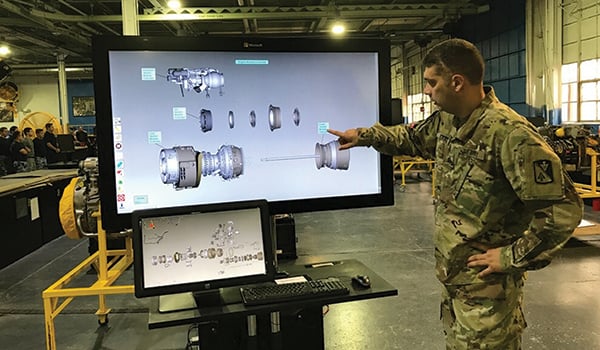
128th Aviation Brigade / By SSG Zachary T. Barber: Three questions must be answered for valuable training to occur: how to train, how to influence, and how to communicate to ensure trainees are learning. The most challenging part for all instructors is to develop the “how.”

SSG Walter Kairuz, a 15B instructor with Co. C, 2nd Bn., 210th Avn. Regt. explains the main modules and subcomponents of the T700 series turbine engine to a 15B10 class on May 5, 2017. / U.S. ARMY PHOTO BY SSG ZACHARY BARBER
All Soldiers do not retain technical knowledge at the same rate because of various levels of education within the ranks. Virtual Interactive Environment (VIE) training aids and simulators throughout the 128th Aviation Brigade have assisted in bridging learning gaps by exposing young Soldiers to multiple learning domains.
VIE training devices have been a valuable tool used within the Army Aviation community by providing a virtual experience for the next generation of aviation maintainers. The VIE is available in a variety of multi-monitor configurations and has the capability to duplicate information from a primary monitor and mirror it onto secondary screens. The configurations include: single, dual, and triple monitor systems allowing for an expansion of the visual workspace. The VIE allows state-of-the-art, realistic T700/701 series turbine engine operation training inside classrooms and on the hangar floor. VIE capabilities allow 128th Aviation Brigade trainees to learn in a high tech environment with the ability to virtually disassemble, isolate, and reassemble components and display three-dimensional cut-out views. The virtual programming, mixed with years of operational Army expertise enhances the learning experience of the trainees and streamlines the program of instruction. VIE also allows instructors to effectively explain turbine engine theory, operation, and how individual components and subsystems interact.
How It Works
The VIE efficiently demonstrates procedures for a multitude of common tasks, such as replacement of igniter plugs to the more complex task of removal and installation of a power takeoff drive assembly. The VIE breaks down each process into a step-by-step procedural explanation that is easy to follow for maintainers of any skill level. VIE maintenance procedures also incorporate short video clips to aid with instruction. The video clips show trainees each bolt, nut, and electrical connector being removed or disconnected. Users can also zoom into the area of the hardware being removed while displaying what necessary tools are needed. The VIE can virtually manipulate any component on the engine within a matter of seconds.
The VIE training device’s multi-dimensional capability also facilitates the Cognitive, Psychomotor and Affective domains of learning. The Cognitive learning domain is the ability for a Soldier to attain knowledge on a certain subject or topic. It sets the foundation for Soldiers when an instructor is able to relate to real life experiences to help trainees remember, understand, and apply technical skills. The VIE allows the instructor to infuse their experience with the VIE program and expanding on existing lesson plan material. The Psychomotor domain covers hand and eye coordination, physical movement, and the use of motor-skills. The VIE is not hands-on, but it does give an extensive visual tool which allows trainees to receive a detailed explanation of components and adds value to concurrent hands-on training. Finally, we have the Affective domain, which drives motivation, attitudes, and a trainee’s perception of turbine engine maintenance.
The newest generation of Soldier is extremely comfortable with technology, touch screen devices, and instant data. Leveraging Virtual Interactive Environments during training will capture and hold the attention of the next generation of Army Aviation maintainers for years to come.
SSG Zachary T. Barber is a 15B instructor/writer with Co. C, 2nd Bn., 210th Avn. Regt. at Joint Base Langley-Eustis, VA. He is a non-commissioned officer with 10 years of aviation experience and a veteran of Operation Enduring Freedom.










